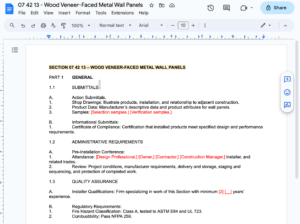Welcome to the “Comprehensive Guide to CSI Construction Documentation Standards.” Your essential resource for navigating and mastering the core standards developed by the Construction Specifications Institute (CSI). These standards—CSI Masterformat, PageFormat, SectionFormat, and 3-Part Specifications—serve as the backbone of professional construction documentation. Ensuring clarity, consistency, and efficiency across the construction industry.
In the complex world of construction projects, clear and standardized documentation is vital. It facilitates effective communication among architects, engineers, contractors, and suppliers, minimizing misunderstandings and streamlining the construction process. This guide is designed to provide you with a deep understanding of each standard. Its purpose, and how it fits into the broader context of construction documentation.
MasterFormat: The classification system that organizes construction specifications, work results, and construction practices into a standardized structure. Making it easier to understand and manage project requirements.
PageFormat: Guidelines for the physical layout of specification documents. Ensuring information is presented in a clear and accessible manner for all project stakeholders.
SectionFormat: A framework for structuring the content within each specification section, promoting consistency and ease of information retrieval.
3-Part Specifications: The detailed approach to writing specifications. Divided into General, Products, and Execution sections, providing a comprehensive description of materials, products, and work processes.
Whether you’re an architect drafting your next project, a contractor interpreting specifications, or a student learning the ropes of construction management, this guide offers valuable insights and practical advice to harness the full potential of CSI’s documentation standards. Let’s embark on this journey to enhance your proficiency and confidence in creating and utilizing construction documents that stand the test of time and complexity.
What is CSI MasterFormat?
CSI MasterFormat specifications refer to a standardized system for organizing construction documents and specifications into a consistent format. Developed by the Construction Specifications Institute (CSI) and Construction Specifications Canada (CSC), MasterFormat is widely used throughout the construction industry in North America to streamline communication among architects, engineers, contractors, and suppliers.
The MasterFormat system divides construction information into 50 divisions (as of the 2020 update), each focusing on a specific aspect of construction, such as concrete work, masonry, metals, wood, plastics, and composites, among others. Each division is further subdivided into sections that provide detailed specifications for materials, products, and workmanship.
The main objectives of CSI MasterFormat are to:
- Facilitate communication: By providing a common language and standardized format, MasterFormat helps reduce misunderstandings and confusion among all parties involved in a construction project.
- Enhance project organization: It organizes project manuals, detailed cost information, and relating drawing notations in a structured manner, making it easier to navigate and manage documentation.
- Improve information retrieval: The standardized format allows for quick access to specific sections of a project manual or specification document. Saving time and increasing efficiency.
- Promote consistency: Using a uniform structure across all projects and documentation ensures consistency in the presentation of information. Which is particularly beneficial for comparison and analysis purposes.
CSI MasterFormat is continually updated to reflect changes and advancements in the construction industry, with revisions addressing new technologies, materials, and practices. It serves as an essential tool for professionals involved in construction projects, from the planning and design phase through to construction and maintenance.
What is CSI SectionFormat?
CSI SectionFormat is a set of guidelines developed by the Construction Specifications Institute (CSI) for organizing the content within each section of a construction specification document. While CSI’s MasterFormat provides a system for categorizing the work into divisions and sections. CSI PageFormat offers guidance on the physical layout of pages, SectionFormat focuses on the internal organization of information within individual sections to ensure consistency and clarity.
SectionFormat divides each specification section into distinct parts, with recommended standard article titles that include:
- General: This part provides an overview of the section, including descriptions of the scope of work, definitions, quality assurance requirements, and submittals. It sets the stage for the detailed requirements that follow.
- Products: This section details the materials, equipment, and products to be used in the project. It specifies manufacturers, product characteristics, physical and performance criteria, and related requirements.
- Execution: The final part outlines the installation or application procedures, including examination, preparation, installation, erection, and verification of performance criteria. It also covers field quality control and manufacturers’ services.
The use of SectionFormat helps ensure that each specification section is organized in a manner that is familiar to all users. Making it easier to find specific information and understand the requirements. This consistency in organization contributes to more efficient review and use of the specifications during the construction process.
SectionFormat is part of CSI’s suite of standards aimed at improving the quality and efficiency of construction documentation. By adhering to these guidelines, architects, engineers, and construction professionals can create clearer, more accessible documents that facilitate better communication among all parties involved in a project.
What are CSI 3-part specifications?
CSI 3-Part Specifications are a format developed by volunteers. Maintained by the Construction Specifications Institute (CSI) to organize project specifications into three distinct parts:
- General: This part provides requirements for submittals, quality assurance, related sections, warranty and other administrative processes. It sets the stage for the detailed requirements that follow. And may include administrative and procedural requirements specific to the section.
- Products: This section details the materials and products to be used, specifying manufacturers, product characteristics, performance criteria, and related requirements. It ensures that the materials and products meet the project’s design and performance standards.
- Execution: The final part outlines how the products and materials are to be installed, applied, or executed. It includes preparation, installation methods, quality assurance tests, inspections, protection, field testing, and procedures. To ensure that the execution meets the specified standards.
The CSI 3-Part Specification format is designed to provide a comprehensive. And detailed description of project requirements in a clear, concise, and consistent manner. This format is part of the broader MasterFormat system. Used to structure specifications for individual sections or divisions of a construction project.
The 3-Part format helps streamline the specification process. Making it easier for architects, engineers, contractors, and suppliers to understand the project requirements and ensure compliance with the desired outcomes. It facilitates better communication among all parties involved in the construction process. And contributes to the overall efficiency and quality of construction projects.
A complete list of specifications for construction are available at this link.
What is CSI PageFormat?
CSI PageFormat is another guideline developed by the Construction Specifications Institute (CSI) focused on the layout and organization of information within construction documents and specifications. While MasterFormat deals with the categorization of work and 3-Part Specifications outline the content and structure of individual specification sections, PageFormat provides a standardized approach to the actual presentation of information on the pages of construction documents.
The primary goal of CSI PageFormat is to promote consistency and clarity in the way information is displayed. Making it easier for all stakeholders in a construction project to find, understand, and use the information contained within the documents. This is particularly important given the complex nature of construction projects. And the diverse range of professionals who rely on these documents.
Key aspects of PageFormat include:
- Uniform Page Layout: Recommendations on how to consistently arrange titles, headings, margins, and text to enhance readability and navigability.
- Standardized Section Organization: Guidelines on organizing the content within each section of a specification document. Including the use of consistent headings and subheadings.
- Clear Identification: Instructions for clearly identifying project information, revision dates, and section numbers on each page to facilitate easy reference and updates.
- Accessibility: Suggestions for making documents more accessible and user-friendly, including considerations for electronic formats and digital documents.
By adopting CSI PageFormat guidelines, firms can produce specification documents that are easier to use and reduce the risk of misinterpretation or oversight. This consistency not only improves efficiency during the design and bidding phases of a project but also during construction and administration. As clearer documents can lead to fewer errors and disputes.
CSI PageFormat works hand in hand with CSI MasterFormat Specifications. And SectionFormat (which provides guidance on organizing the content within each section) to create a comprehensive framework for construction documentation that is standardized, efficient, and effective.



